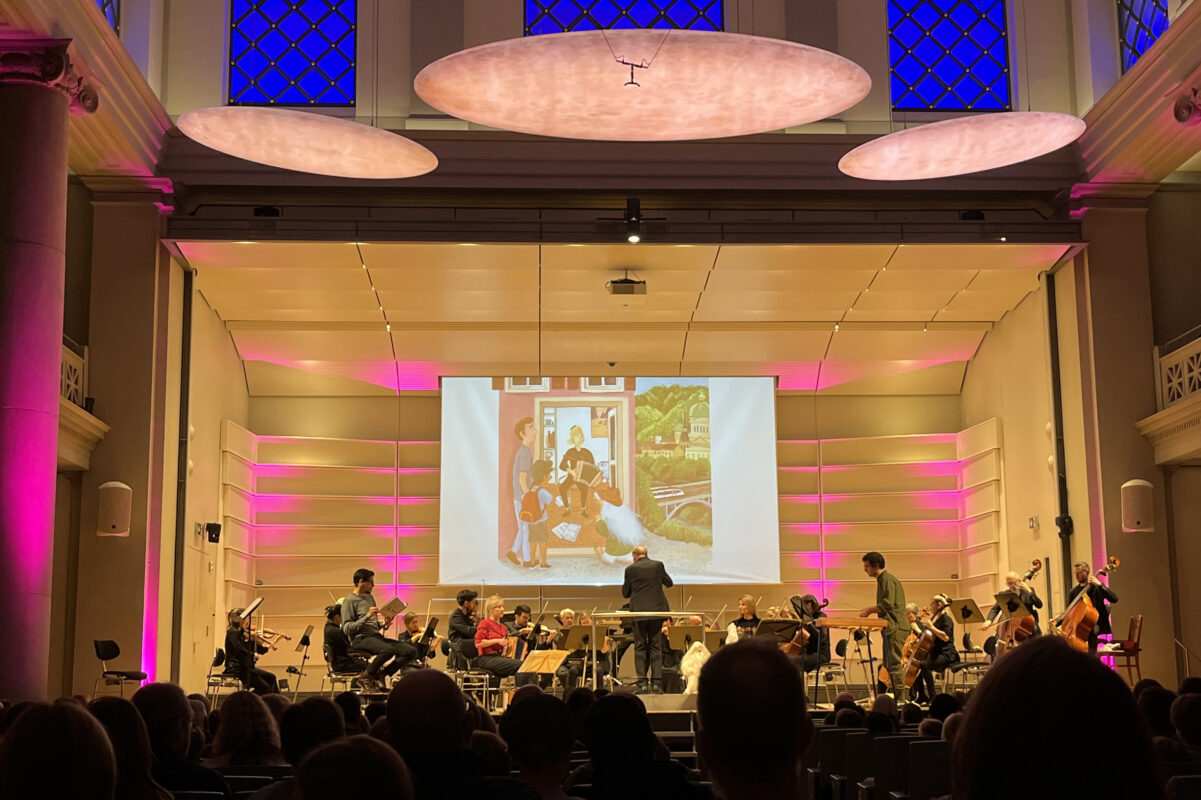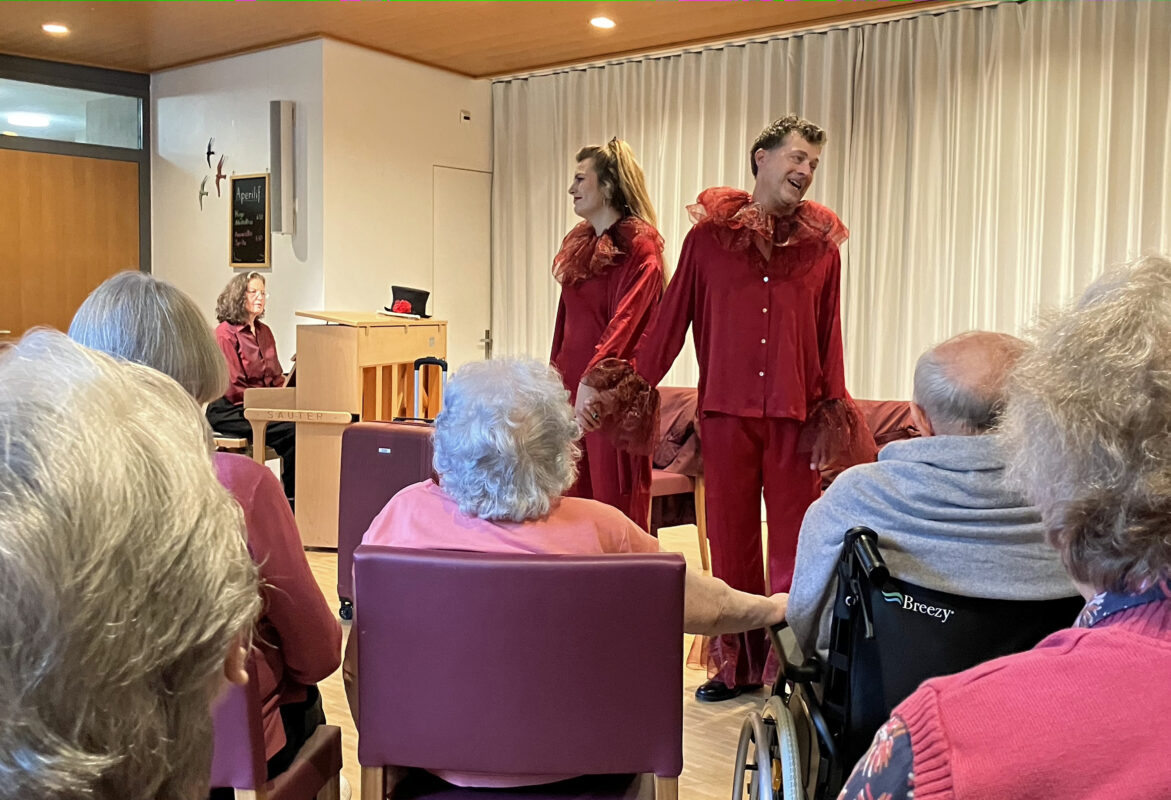Bells on instruments and mouths
For the project "rau-sch-end 2025-1898", Thilo Hirsch and the Ensemble Arcimboldo teamed up with a school class, who practiced listening more closely and making themselves heard.

Three children shout "Hello" and wave to the audience. They are standing in the middle of a music machine in Basel's Tinguely Museum. Their bright voices stand out from the dark, groping, metallic-colored sounds with which the ten-piece Ensemble Arcimboldo plays Mauricio Kagel's composition 1898 for children's voices and instruments. With trumpets, trombones and tubas, three brass instruments are included. The string instruments also have a metal funnel instead of a resonating body. These are so-called straw instruments, which were used for orchestral recordings at the beginning of the 20th century.
Maurizio Kagel had 1898 for the 75th anniversary of Deutsche Grammophon in 1973. He wanted a "vocally untrained school class" to take part in this work. The children were to bring a spontaneous, even slightly anarchistic element into the adult world. For the concerts in Basel, the choice fell on class 5a from Niederholz elementary school in Riehen, who now stand on the stage ramp in full size and react to the music with laughter, cooing and sometimes hissing. A pupil sticks a cheeky drawing on the conductor Thilo Hirsch's back.
Straw instruments
The musical director of the Basel ensemble Arcimboldo came up with the idea for this unusual project entitled rough-sch-end 2025-1898which is sponsored by the Ernst von Siemens Foundation. Hirsch has long been fascinated by the Stroh instruments, named after their inventor Johannes Matthias Augustus Stroh. At various online auctions, he was able to acquire several bell instruments, all of which are in use, including a violin, a cello, a stroviol, a fono fiddle and a fonoukulele. The instruments Kagel used for the premiere of 1898 The instruments that were built are now owned by the Paul Sacher Foundation, but are no longer playable.
As the children only get to play short passages, Hirsch commissioned another work from the composer Abril Padilla. Together with Naja Parejas, she also led the workshops that were held with the pupils over a period of two and a half months. Including final rehearsals for the three concerts on October 25 and 26 at the Tinguely Museum in Basel, the work took around 40 hours.
Tinkering and listening
Padilla has already worked on previous projects such as the Resonance box worked together with Hirsch. "In the beginning, our workshop was about concentrated listening. Kagel's music was initially quite foreign to the children." They practiced the differences between sincere and artificial laughter, as Kagel describes it in the score. The children discovered their voices through play. For their newly written composition EN‧MO sound funnels were made. "These amplifiers helped individuals to become more courageous," says Padilla. The children's rights addressed in her work were chosen together.
The concert evening begins EN‧MO directly after Mauricio Kagel's Old/New for solo trumpet. A few children put their bells to their ears so that they can listen even better to Jonathan Romana's torn-off sound figures. Then they imitate the sounds of the trumpet - creating a dialog between the musician and the children. The sounds become words: "Clean water", "Fire", "No more racism". Speaking rhythmically, they chant: "Environmental protection is important, environmental protection is good." Maria Luisa Pizzighella gives the words even more power on the drums. EN‧MO is more designed text than music, but a short vocal interlude by a boy is also part of the work.
Laugh and rustle
The varied, dramaturgically tight program also includes Kagel's virtuoso performance of Lanet Flores' Shadow sounds for bass clarinet solo, a tango for straw violin (Juan María Braceras) and piano (Helena Bugallo) by Igor Stravinsky and two further world premieres for fonofiedel (Thilo Hirsch) and gramophone: Charlotte Torresʼ Jungle Jazz Suite and Abril Padillas 78 RPM. The concert ends with a group improvisation led by the children with signs, in which the audience takes part alongside the musicians distributed around the room. The program brochure is folded into a bell. Then it starts with laughter and noise, glissando up and down - and all mixed up. Even the large Tinguely machine behind the stage is set in motion.
When we talk to them after the concert, the children are bursting with information. They think it's great to have been on stage and to have seen the instruments up close. "There were long waiting times during rehearsals, but in the end it was all worth it," says one girl. "We always had to listen carefully and remember when to go on stage," says a boy. Making the bells and using them on stage was also a lot of fun. The two teachers Manon Siebenhaar and Fabian Leuenberger are also satisfied with the project: "The pupils were able to rely on each other. It also strengthened the class community."








